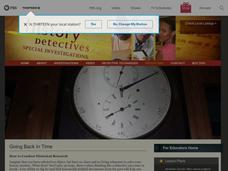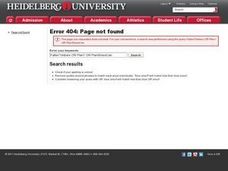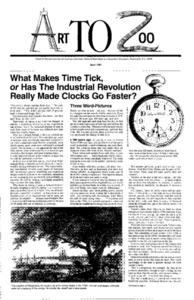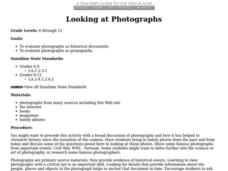National Park Service
It Was a Very Good Year
Waterton-Glacier International Peace Park includes whitebark pines that are over 1,200 years old, meaning they have been there since before medieval times. The second lesson of five details how to read tree rings for climate change and...
American Museum of Natural History
T. Rex Roar Mixer
Scholars predict the sound of a tyrannosaurus rex roar with a mixing board equipped with audio from crocodiles, chickens, loon, macaw, peccary, sea lion, and bison.
PBS
Going Back In Time
History detectives eschew that time machine and follow the paper trail to go back in time to investigate an unfamiliar object. The goal is for class members to develop their skills as historical detectives.
Scholastic
Marijuana: Breaking Down the Buzz
There are a lot of myths surrounding marijuana. Read a passage that clarifies the dangers of teens smoking marijuana, its harmful effects on the development of the brain, and the possible correlation of cigarette smoking to marijuana...
Curriculum Corner
“I Can” Common Core! 1st Grade Language
Support first graders with developing their basic language skills using this Common Core checklist. With each standard rewritten as a positive I can statement, students are encouraged to work hard toward reaching these clear learning...
Curated OER
I Can Be An Archaeologist Book Share
Students read and discuss the book, I Can Be An Archaeologist by Robert B. Pickering, and become archaeologists, themselves, as they examine, sort, and record items in a paper bag and trash from their classroom, as well as 2 others.
Curated OER
Cave Art: Discovering Prehistoric Humans through Pictures
Students explore how people in earlier times used art as a way to record stories and communicate ideas. By studying paintings from the Cave of Lascaux and other caves in France, students discover that pictures are more than pretty colors.
Curated OER
Dating Popcorn
Students simulate the dating process with popcorn. In this geology activity, students discuss how geologist find the age of rocks by gauging the amount of decay of radioactive elements. They have 6 bags of popcorn and each group...
Curated OER
What Makes Time Tick, or Has the Industrial Revolution Really Made Clocks Go Faster?
Students explore the concept of time both historically and in their own lives. Students count the number of times they refer to a clock and the number of scheduled and unscheduled activities in their lives. Students discuss how the...
Curated OER
Arkansas Architectural Styles
Students investigate the various architectural styles of Arkansas. They read a handout, complete a worksheet, view images of architectural styles, and take photos and write descriptions of five style elements they observe in their...
Curated OER
Technology and Oil
Learners demonstrate how much our society depends on petroleum products. They show how advances in technology have allowed us to find, obtain, and transport oil more efficiently.
Curated OER
Grade 3 Spring Themed Word Problems: Problem 1
In this math worksheet, 1st graders solve one story problem which involves multiplying single digit dollar amounts plus addition of money without pennies. There is a work space for students to show their calculations.
Curated OER
Looking at Photographs
Students evaluate photographs as historical documents and photographs as propaganda.
Curated OER
Archaeology
Students compare and contrast the role of scientists with that of archaeologists. They also describe the roles of observations and evidence in science.
Curated OER
Basics of Archaeology
Middle schoolers identify what and how to complete an Archaeological excavation is conducted. They identify the transition from one layer to the next more easily if the colors of the layers are different. When creating a dig, the...
Curated OER
Technology and Oil
Students examine how society depends on petroleum products. They determine how technological advances have improved the ways these products are obtained, found, and transportation.
PBS
Home, Sweet, Home!
Students investigate the local history and architecture of their community. They draw maps, conduct Internet research, discuss varied architectural designs, take a walking tour of their town and work in teams to record their community's...
Curated OER
Determine the Main Idea
Learners identify the main idea of a reading passage. In this identifying the main idea lesson, students read short passages, highlight or underline important information and record the main idea of the passage. They participate in a...
Curated OER
Can I have a Pet?
Students read the book Can I have a Pet?, by Gwendolyn Hudson Hooks. They determine which animals the main character asked to have as a pet, explain why zoo animals do not make good pets, and study the pictures to make predictions.
Curated OER
The Columbian Exchange
Eleventh graders examine the significant consequences of Spanish exploration and settlement of the New World on animals, humans, and plants. They read and discuss an informational handout, define key vocabulary terms, and complete a...
Curated OER
Plate Tectonics
For this science worksheet, learners use basic scientific concepts to complete the series of puzzles that are intended to increase science literacy and focusing upon plate tectonics.
Curated OER
Big Snowball Fight
Students complete pre reading, writing, during reading, and interdisciplinary activities for the book Big Snowball Fight. For this reading lesson plan, students complete journal entries, answer short answer questions, have discussions,...
Curated OER
Introducing the Memo
Students explore memos to gather important information. In this memos lesson, students interpret memos and answer questions based on the information. Students define the parts of a memo. Students create their own memos.
Curated OER
"how To Think Like an Archaeologist" Suggested Pre-visit Activity for Historic Jamestowne
Students study grocery receipts to simulate the archaeological activity of classifying items. They discuss the receipts as if they were find lists.

























